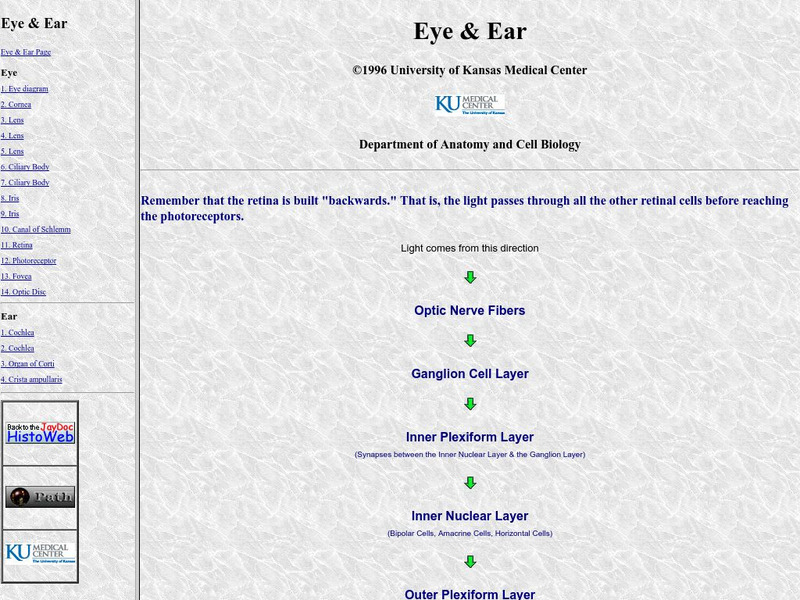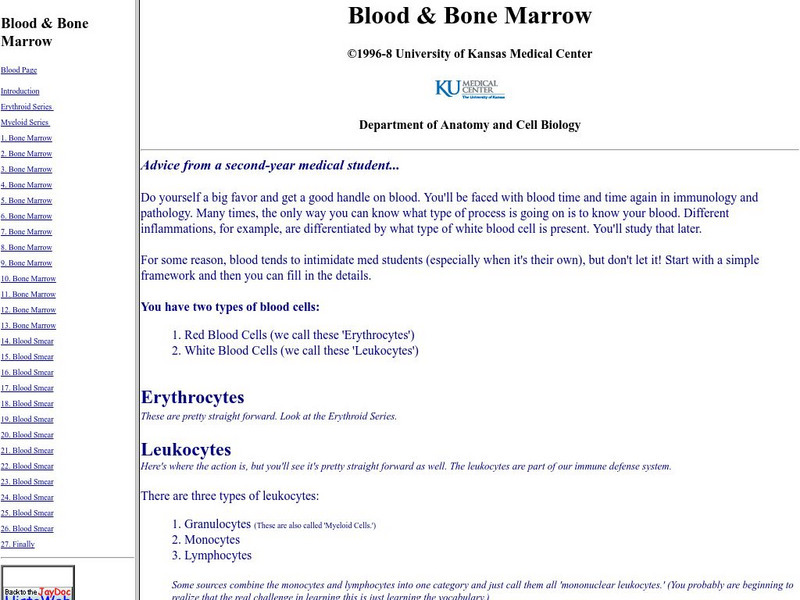Quizlet
Quizlet: 8th Grade Science Vocab Test
Science vocabulary terms are included on this end-of-the-year exam. Words are associated with cells, genetics, and bonds. Seven multiple choice questions, seven matching questions, and six true/false questions are provided on this...
CK-12 Foundation
Ck 12: Organization of the Human Body
[Free Registration/Login may be required to access all resource tools.] A variety of learning opportunuties about levels of organization in the human body. Includes videos, activities, discussion questions, and quizzes.
University of Arizona
The Biology Project: Meiosis Tutorial
This cell biology lesson explains and illustrated the different phases of meiosis. Includes vocabulary and assessment links as well as othe related resources.
South Carolina Educational Television
Know It All: Microscope | Hobby Shop
In this activity, students use a virtual biology lab to perform investigations and learn lab procedures using compound and dissecting microscopes to look at a variety of animal and plant cells.
Children's Museum
The Children's Museum of Indianapolis: Cells the Living School
Students compare the parts of a cell and their functions to their school to understand how a cell's parts work in unison to be effective in the body.
ibiblio
Ibiblio: Virtual Cell Web Page
A teacher- and student-contributed website of 3-D models and explanations of cell structures.
Lawrence Berkeley National Laboratory
Berkeley Lab: Did You Ever Wonder? New Discoveries to Cure Breast Cancer
Students investigate how new discoveries could help cure breast cancer. The article discusses cancer, cells, and Mina Bissell. The resource consists of pictures, quotes, and links to additional resources.
Lawrence Berkeley National Laboratory
Berkeley Lab: Did You Ever Wonder? Why People Age?
Students explore the shifting role of senescent cells throughout the lifespan of organisms. The article discusses cancer, Judy Campisi, and enzymes. The resource consists of pictures, quotes, and links to additional resources.
University of Kansas Medical Center
University of Kansas Medical Center: Glands
Examine the microscopic specimens of various types of glands.
University of Kansas Medical Center
University of Kansas Medical Center: Gastrointestinal System
Investigate the human gastrointestinal system with this extensive collection of microscopic specimens.
University of Kansas Medical Center
University of Kansas Medical Center: Eye & Ear
Understand the structure and function of the eye and ear cells by examining these microscopic tissue samples.
University of Kansas Medical Center
University of Kansas Medical Center: Urinary System
This University of Kansas Medical Center site provides a clickable list of microscopic slide photographs of urinary system cells and tissues.
University of Kansas Medical Center
University of Kansas Medical Center: Bone
See several specimens of microscopic images of bone cells and tissue.
University of Kansas Medical Center
University of Kansas Medical Center: Female Reproductive System
Examine this collection of microscopic specimen images from the female reproductive system.
University of Kansas Medical Center
University of Kansas Medical Center: Blood & Bone Marrow
A collection of specimen samples showing bone marrow and other blood smears.
Science Education Resource Center at Carleton College
Serc: Best Edible Model of a Cell Contest
Learners build a model of a cell using all edible materials. Students must do an oral presentation of the model.
Science Education Resource Center at Carleton College
Serc: Animal and Plant Cell Models and Cell Tour Given to Life Science Students
A biology class is divided into two groups: one an animal cell, and the other one, a plant cell. They are given a list of cell organelles to research and construct in their 9 M X 9 M model. Students must organize and assign duties,...
Palomar Community College District
Wayne's Word: Comparison of Plant and Animal Cells
Students can learn about the location and the function of the major organelles in plant and animal cells. Resource includes descriptions of the functions of cell parts as well as a diagram of the two cell types.
Wikimedia
Wikipedia: Anton Van Leeuwenhoek
This site from the Wikipedia encyclopedia provides a concise explanation of van Leeuwenhoek's (1632-1723 CE) contribution to the improvement of the microscope and his contributions to cell biology.
Ohio State University
Ohio State University: Plant Cells
Use this informative essay and these great illustrations to learn how plant cells are different from animal cells.
TED Talks
Ted: Ted Ed: Your Body's Real Age
Do all of your cells get switched out for new ones every seven years or so? Does anything remain with you throughout your entire life? These are the questions addressed by NPR's Skunk Bear. [3:09]
SEDL
The Human Body [Pdf]
A large PDF unit that teaches young scholars about the human body systems. Incorporates many activities and integrates math and language arts.
Science Museum, London
Science Museum: What Do Your Cells Do?
Information on cells, including looking at cells, what a cell is made of, how cells make proteins, why cells differ, and new cells for old.
Other
Miami University: Cellular Nature of Life?
Basic information about cells in an outline form. Gives good information in an abbreviated format.





















